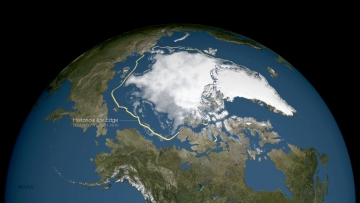691223_1_Losing Ice_360 px width.jpg

Earth's polar ice sheets are melting, but the ice loss in Greenland is happening at a faster rate than in Antarctica due to warmer temperatures. Credit: NOAA Satellites
The two largest ice sheets on Earth sit atop Antarctica and Greenland. But they’re both getting smaller in a hurry. They’re contributing to the rise in global sea level—about an inch over the past few decades. The rate at which the sheets vanish isn’t the same, though—Greenland’s is disappearing much faster.
The ice sheets can be hundreds of feet thick. But as the climate has warmed up, they’ve been shrinking. According to one study, from 1992 to 2020 they lost a combined eight trillion tons of ice, with Greenland contributing more than half of the total.
That’s a bit surprising, because the Antarctic sheet contains more than eight times as much ice as Greenland’s. But they’re disappearing for different reasons.
The Antarctic sheet disappears as shelves of ice that extend over the ocean break off and float away. That’s happening more often because changing winds are driving warmer water toward parts of the continent. As the icebergs move out, more ice glides from the land into the sea—raising the global sea level.
About half of Greenland’s ice loss is driven by the same process. But the other half comes from melting. Greenland has warmed up more than the rest of Earth—by about four degrees Fahrenheit in summer, and nine degrees in winter. Some of the water trickles to the bottom of the ice. It lubricates the rocks below, so the ice flows toward the ocean faster—contributing to the demise of Earth’s second-largest ice sheet, and the rise in global sea level.

